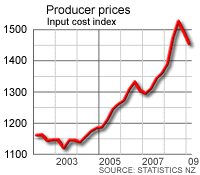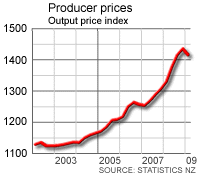 New Zealand producers' input prices fell 2.5% in the March quarter from December, largely as a result of lower crude oil prices, Statistics New Zealand (Stats NZ) said today. (Update 1 includes comparison with expectations.) The 2.5% fall in the Producers Price Index (PPI) was the largest quarterly fall since the series began in December 1977, Stats NZ said. This followed a 2.2% fall in the December quarter after the PPI had risen for six consecutive quarters from June 2007. The March PPI was up 4.7% from the same time last year. This result will help reassure the Reserve Bank that the inflation outlook is under control, giving it room to keep cutting the Official Cash Rate, although most banks are yet to pass on recent cuts to floating mortgage rates and deposit rates. The result was also way below economist expectations. A Reuters poll of economists showed a median prediction of a 0.2% fall in input prices. Transport and storage prices were down 9.9% from December, with air transport prices down 14.4%.
New Zealand producers' input prices fell 2.5% in the March quarter from December, largely as a result of lower crude oil prices, Statistics New Zealand (Stats NZ) said today. (Update 1 includes comparison with expectations.) The 2.5% fall in the Producers Price Index (PPI) was the largest quarterly fall since the series began in December 1977, Stats NZ said. This followed a 2.2% fall in the December quarter after the PPI had risen for six consecutive quarters from June 2007. The March PPI was up 4.7% from the same time last year. This result will help reassure the Reserve Bank that the inflation outlook is under control, giving it room to keep cutting the Official Cash Rate, although most banks are yet to pass on recent cuts to floating mortgage rates and deposit rates. The result was also way below economist expectations. A Reuters poll of economists showed a median prediction of a 0.2% fall in input prices. Transport and storage prices were down 9.9% from December, with air transport prices down 14.4%.
 Producers' output prices fell 1.4% in the March quarter after seven consecutive quarterly rises, Stats NZ said. This compared to a median expectation of a 0.3% rise in the Reuters poll. "The dairy product manufacturing index (down 24.3%) had the greatest downward impact on the output prices in the March 2009 quarter," Government Statistician Geoff Bascand said. "The fall in the latest quarter is the highest recorded since the series began in the June 1994 quarter, and it followed a 19.2% rise in the December 2008 quarter and 2.5% fall in the September 2008 quarter. The main driver of the index in the latest quarter was lower prices for exported dairy products such as skim milk powder, cheese and butter," Bascand said. JP Morgan economist Helen Kevens said the PPI result gave the RBNZ further room to cut the OCR. "In terms of the policy outlook, if anything, today's PPI report reaffirms our view that the RBNZ has plenty of scope to ease policy further. We anticipate a 25bp rate cut on June 11, which will take the OCR down to 2.25%, our terminal cash rate forecast for this cycle," Kevans said. "The June decision will be a close call, however. On the one hand, there is the risk that the RBNZ sits on the sidelines, possibly wanting to preserve monetary policy power for use at a later date - the case can still be made for the RBNZ to wait until (the second half of 2009), when the unemployment rate is soaring, before delivering further policy support. On the other hand, however, with inflation pressures easing, the weakness in private consumption (as indicated by data on Friday showing a record drop in retail volumes in 1Q), and the falling terms of trade, further policy easing, in our view, is warranted."
Producers' output prices fell 1.4% in the March quarter after seven consecutive quarterly rises, Stats NZ said. This compared to a median expectation of a 0.3% rise in the Reuters poll. "The dairy product manufacturing index (down 24.3%) had the greatest downward impact on the output prices in the March 2009 quarter," Government Statistician Geoff Bascand said. "The fall in the latest quarter is the highest recorded since the series began in the June 1994 quarter, and it followed a 19.2% rise in the December 2008 quarter and 2.5% fall in the September 2008 quarter. The main driver of the index in the latest quarter was lower prices for exported dairy products such as skim milk powder, cheese and butter," Bascand said. JP Morgan economist Helen Kevens said the PPI result gave the RBNZ further room to cut the OCR. "In terms of the policy outlook, if anything, today's PPI report reaffirms our view that the RBNZ has plenty of scope to ease policy further. We anticipate a 25bp rate cut on June 11, which will take the OCR down to 2.25%, our terminal cash rate forecast for this cycle," Kevans said. "The June decision will be a close call, however. On the one hand, there is the risk that the RBNZ sits on the sidelines, possibly wanting to preserve monetary policy power for use at a later date - the case can still be made for the RBNZ to wait until (the second half of 2009), when the unemployment rate is soaring, before delivering further policy support. On the other hand, however, with inflation pressures easing, the weakness in private consumption (as indicated by data on Friday showing a record drop in retail volumes in 1Q), and the falling terms of trade, further policy easing, in our view, is warranted."

We welcome your comments below. If you are not already registered, please register to comment.
Remember we welcome robust, respectful and insightful debate. We don't welcome abusive or defamatory comments and will de-register those repeatedly making such comments. Our current comment policy is here.